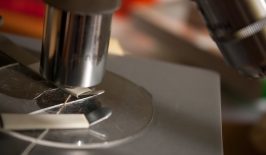A new paper-based battery offers an innovative way to generate power, utilising tiny amounts of fluid already provided for medical diagnostics to create charge.
Most batteries found in portable devices are lithium-ion batteries, currently powering everything from Tesla cars to your smartphone to your watch. Global lithium demand is expected to increase significantly as electric vehicles continue to prove their worth and lithium-ion batteries have the greatest advantages when it comes energy density storage.
But li-ion batteries are non-disposable, and contain toxic materials detrimental to the environment if they are not properly treated, which comes at significant expense. In addition, while these types of batteries will last the longest for daily use and are therefore the default, when it comes to the one-use batteries used in many medical devices, we often utilise as little as one per cent of the potential energy within.
Barcelona-based Fuelium, working from the National Centre of Microelectronics at the Autonomous University of Barcelona, isn’t looking to disrupt the li-ion battery market completely – just the button batteries which are used in small portable devices the world over. The miniature paper-based batteries they’ve developed are hugely innovative in that they don’t have a charge stored in them – instead, they create potential from electrochemical reactions, which can be harnessed to deliver power. These reactions can be with common liquids and fluids.
The practical upside here is that these batteries can be used with portable electronic devices used for in-vitro diagnostics. The sample to be tested – such as blood, or urine – is added to the paper-battery and a natural capillary action forces the liquid to combine throughout the base material to create sufficient potential to power the device on.
In this way, power is literally generated by blood, sweat and tears!
One common example of how it could be used effects millions of people with Type 1 or Type 2 diabetics. Sufferers need to prick their fingers regularly to extract a small blood sample, add the sample to a test strip and plug it into a measuring device in order to get an accurate blood-sugar reading. While ‘button’ batteries are capable of supplying the small amount of sporadic power required for many months, they are costly and detrimental to the environment. Most are thrown away after using just a tiny percentage of the chemical potential energy contained within, given how difficult battery technology is to perfect.
Fuelium’s batteries generate only the amount of power required and, because the paper batteries can be integrated with sensors, they create an entirely new ecosystem, where battery and sensor strip are combined. And after use, because they’re made of simply paper and non-toxic metals, they can be disposed without any need for resource-intensive and costly recycling processes. The batteries can supply between 1-6V, and between 1 and 100mW of power.
For all you need to know about the world’s ever-growing mountain of Electronic Waste and what’s being done to tackle it, check out our Knowledge article right here.






